To run the forums, host the website, and travel, I charge a universal service fee for most of my reviews (not this one). This in-depth review was not sponsored by Kona. My goal is to be transparent and unbiased with you, this video and writeup are not meant to be an endorsement of Kona products or Cit-E-Cycles… I covered it for the sake of variety and because Doug said it was popular at his shop in Vancouver, Canada. I welcome your corrections, additions, and feedback in the comments below and the Kona electric bike forums.
Observations:
- The Dew-E is based off of the long-running Dew model, an analog bicycle (human powered) that has been popular with commuters and city cyclists. Kona said that they basically added a drive system to that exact bike, striving to maintain the same beloved geometry and sizing options
- With quick release wheels, an easy to remove battery with ABUS Plus key (that can be matched to ABUS locks to reduce the number of keys/clutter you require as an owner), and a removable display, this bike is very versatile. No suspension, but the wider 1.75″ tires offer some comfort, and you could get a 27.2mm suspension seat post and suspension stem to reduce vibration without adding too much weight (as with a full suspension fork). The narrower handlebar is going to be easy to fit through doors and between cars or crowded cycling areas.
- This ebike uses the lightest weight Bosch battery pack (the PowerPack 400), but is also compatible with the 25% higher capacity Bosch PowerPack 500. Both packs are known for being reliable, durable, and easy to replace or borrow/rent, which means you could fly with the bike and find power on location much easier than a lot of competing products. Ebike batteries usually aren’t allowed on commercial flights
Pros:
- The bike comes in five sizes to really let you optimize fit… which is important for a high-step only frame. The geometry is comfortable (more upright than I was expecting from a flat bar)
- Even though the frame and fork are aluminum alloy (known for being light but stiff), the geometry and wider 1.75″ tires made it feel pretty comfortable. This is an active bike frame with a more forward geometry in general, but it didn’t feel as harsh as some competing products I’ve covered in the past, like the Raleigh Redux iE for example
- Kona used butted tubing for the frame, meaning that the wall thickness increases towards the ends for increased strength. The wall thickness decreases towards the middle of tubes to help keep the bike weight down
- This ebike is fairly lightweight at just 43lbs (19.5kg), and most of the extra weight is positioned low and center for optimal balance and handling. The Bosch Active Line Plus motor only weighs 7.05lbs and the PowerPack 400 is 5.5lbs
- The Bosch PowerPack batteries are interchangeable, so you could buy or borrow a PowerPack 500 and it would work with this bike! These packs have been around for many years now (at least 5 in North America) and are easy to borrow or rent. They are known for being reliable and I love the integrated handle for safe transport
- I love all of the attachment points on this ebike! The fork has bosses for an optional front rack, the rear seat stays have two threaded eyelets, and there’s a bottle cage mounting spot on the seat tube. This frame also has room in the main triangle for a frame bag… and this triangle can be used to lift and hang the bike more easily on car and bus racks
- Even though the frame looks fairly generic to me, it’s very purpose built. Note the custom bottom bracket interface, internally routed cables, and stepped-down battery mounting spot on the downtube. This frees up the center triangle and provides a big flat spot for more secure mounting of the battery interface
- I love the ebike display that Kona chose for this model, it’s the larger Bosch Intuvia! This display is easier to read, offers more readouts (like shift recommendation), and can be removed for safe storage and reduced tampering. It even has a Micro-USB port built into the top right side for smartphone or other electronic accessory charging.
- Note the custom B&M accessory adapter that replaces the standard Intuvia lower bracket and allows for a headlight! This positions the headlight perfectly, up high, out of the way from the display, and it can still be aimed independently. The headlight points where you steer and has side window cutouts. It’s perfect in my book.
- Great kickstand choice and placement, towards the rear of the frame to eliminate pedal lock. The stand uses a standard 40mm mounting provision and offers length adjustability. You need a Torx driver to adjust length (vs. a standard hex wrench) and I think they chose this because you can work at it from an angle vs. having to be straight on with most hex wrenches… can still be a little inconvenient if you’re in North America where Torx is less common
- Decent brake setup here, the Shimano 160mm hydraulic disc brakes work fine for a lightweight Class 1 urban-oriented electric bike… and by not going with 180mm rotors, there’s less chance that they will collide with bike racks and get bent
- Great attention to detail here: black spokes, hubs, and rims, co-branded grips (with removable plugs so you could add a bar mirror) and saddle (comfortable saddle from Velo), sturdy aluminum alloy chainring guard (bash guard) from FSA, clean durable plastic cable wraps
- Unique 650B wheel size strikes a balance between the low attack angles and smooth rolling momentum of a wide 700c 28″ wheel and the approachability and wider tire compatibility of a 26″ wheel. The 650B 27.5″ setup became popular on mountain bike products around 2017, and it works well here as versatile urban setup
- Both wheels have quick release skewers, making them easier to take off for transport, flat fixes, and secure locking at racks. It fits with the easy to remove display and battery pack, making this a convenient very utilitarian electric bicycle
- Great tires, I’m familiar with the WTB brand and appreciate the beautiful tan sidewalls, puncture resistant layer, reflective stripes, and smooth finish. The wider 1.75″ design makes these stable and adds comfort, thanks to increased air volume
- The motor is very quiet and efficient, I’m glad Kona went with the Active Line Plus vs. just Active, because it provides that extra bit of torque and pedal cadence support that most active cyclists can appreciate and enjoy
- The Bosch Active Line Plus motor lets you cycle the chain backwards through the drivetrain which can be handy for lubing the chain and performing bike maintenance without a stand
- The Bosch electric bike motor controller measures rear wheel speed, pedal cadence, and pedal torque over 1,000 times per second and is one of the more reliable and reputable ebike drive systems around. Bosch has partnered with Magura in North America to provide great customer support if issues arise. The motor even offers shift detection, which reduces chain and drivetrain wear by easing power back when it senses gear changes in motion
- Since it’s so easy to remove the battery pack, I feel like this ebike could be great for people who have to park outside… they can bring the display and pack in to protect from the elements. I have been taught that storing the battery at half full and away from extreme heat is best for lithium-ion cells. Extreme cold will temporarily stunt the battery, and limit range, but isn’t as damaging as extreme heat
- The battery pack locks into the frame using an ABUS core with PLUS keys that can be matched to ABUS locks, it’s a great setup and one of the highest-end locksets around, more info on the official ABUS website.
- My understanding is that Kona launched in the mid-1980’s and probably had its first bicycles in 1988 or 1989. They’ve been around for a long time, and their staff was very easy to reach and very friendly even in 2020. Apparently it’s still owned 50/50 by the two original founders and the team has grown to around 75 people. They launched their first three ebikes in 2010, so I feel like they are very committed to the space and stable compared to some newer less proven brands
- Kona launched in Kerrisdale British Columbia (near Vancouver), so if you’re a Canadian or live in the Pacific Northwest like Washington State, these guys are local. They feel authentic to me
Cons:
- The bike only comes in one color option, though it appears they update it yearly because 2019 was black vs. metallic blue?
- In my opinion, the bike doesn’t look as cool or integrated as some of the other city/commuting products I’ve seen recently that have internal batteries and more custom fenders. The Dew-E looks more like a bike that was converted to ebike vs. a purpose-built electric bike… and that’s one of Kona’s talking points actually, that they tried to preserve what people love about the Dew, so this is kind of a mixed “con” and you do get the benefits of a lighter more accessible battery. Maybe it’s just the fenders that I’m not super impressed with
- Kona has grown to a 75-person company since 1988, but might not be as easy to find in shops as some larger brands. They offer a lifetime warranty, support the two-year Bosch drive systems warranty, and have a one-year comprehensive warranty on this bike
- As shown in the video review, you have to be extra sure that the battery is clicked into position or it could tumble out. I test rode a brand new Dew-E, so the battery interface might have just been a little tight, push down and listen for a click and maybe pull up to double check before riding
- The grips are Kona branded and felt okay, but aren’t locking. I like the size and style of the platform pedals, they felt grippy but were made of plastic vs. aluminum alloy or magnesium
- Not a huge complaint, but the battery charging port on the bike is positioned pretty low. It’s almost hidden beneath the base of the PowerPack battery casing, so you might have to bend down to see clearly and plug in. It’s on the non-drivetrain side of the bike, so the bike will probably be tipping towards you onto the kickstand, and this position is directly in the path of the left crank arm which can collide and snag the charger cable. This design setup is just the Bosch default and is convenient because it doesn’t require extra cables on the bike or extra frame holes
- I didn’t see a slap guard on the right chainstay. You could easily purchase a clear sticker chain protector on Amazon, or a neoprene wrap. You could even use some clear box tape to make your own… I was just surprised to not see it standard, since the paint is so beautiful and they were so detailed with the aesthetic
- Honestly, it would be nice if the bike came with a rear rack that could attach to the rear fender. This would reduce a lot of bouncing and give you a nice matching part for hauling trunk bags and panniers… it’s something that most commuters buy anyway, so why not include a high quality matching rack from the git-go?
- This is a minor thing, but Kona is using the older rear wheel speed sensor and spoke magnet on this bike. Bosch has a new design that positions these near the disc brake caliper and rotor mount so your spoke won’t get loose and the magnet won’t get bumped out of position as easily
- The Bosch Active Line Plus motor is very quiet and efficient, but it doesn’t offer the same high torque power as Performance Line motors and cadence support is limited to 105RPM vs. 120RPM. That means, if you downshift while heading into a big climb, the motor might not be able to keep up with your fast pedaling. If you slow down as a result of this, you might need to downshift again and again until your pedal strength and the motor RPM equalize for support… this isn’t the end of the world, it’s just not as flexible for high-cadence pedaling and sporty riding. For context, I think the older Dew-E did use a Performace Line motor, but with the Bosch reduction gearing that introduced some drag. You get a standard sized chainring with the MY20 motors, but they opted for the Active Line Plus vs. the more expensive Performance Line with upgraded chainring setup
- The Bosch Active Line and MY20 Performance Line motors introduce a sort of “clunk” feeling when I stop pedaling. It’s like there’s some inertia built up in the motor or drivetrain that dissipates with a feeling and sound that the higher-end Performance Line Speed and CX motors do not have… perhaps this isn’t as noticeable with time if the motor breaks in? I mainly test brand new ebikes but almost always notice this “clunk” feeling, which I describe in the video review above
- The steel chainring is very standard, there’s no narrow-wide tooth pattern or guide element to help retain the chain. It could hop off inwards towards the motor casing on very rough terrain, but this is a minor concern for an urban/city ebike with smooth tires and no suspension
- Considering the relatively high price of these electric bikes, some people might wonder why Kona didn’t opt for the higher capacity Bosch PowerPack 500. Perhaps it was a weight savings choice? They are using the more efficient Active Line motor and included the smaller/lighter Compact charger as well, so it all sort of matches in that sense.
- The Bosch Active Line and Performance Line motors have a larger q-factor than competing mid-drive units from Shimano, Yamaha, and Brose. The width is 175mm, and that spaces the crank arms out a bit further… not that big of a deal, but worth mentioning because a standard analog bicycle q-factor is usually 145mm to 157mm on road, city, and gravel bikes
Useful Resources:
- Official KONA website
- Bosch Intuvia ebike display settings
- KONA ebike shop directory to find a KONA dealer near you for fitting and test rides

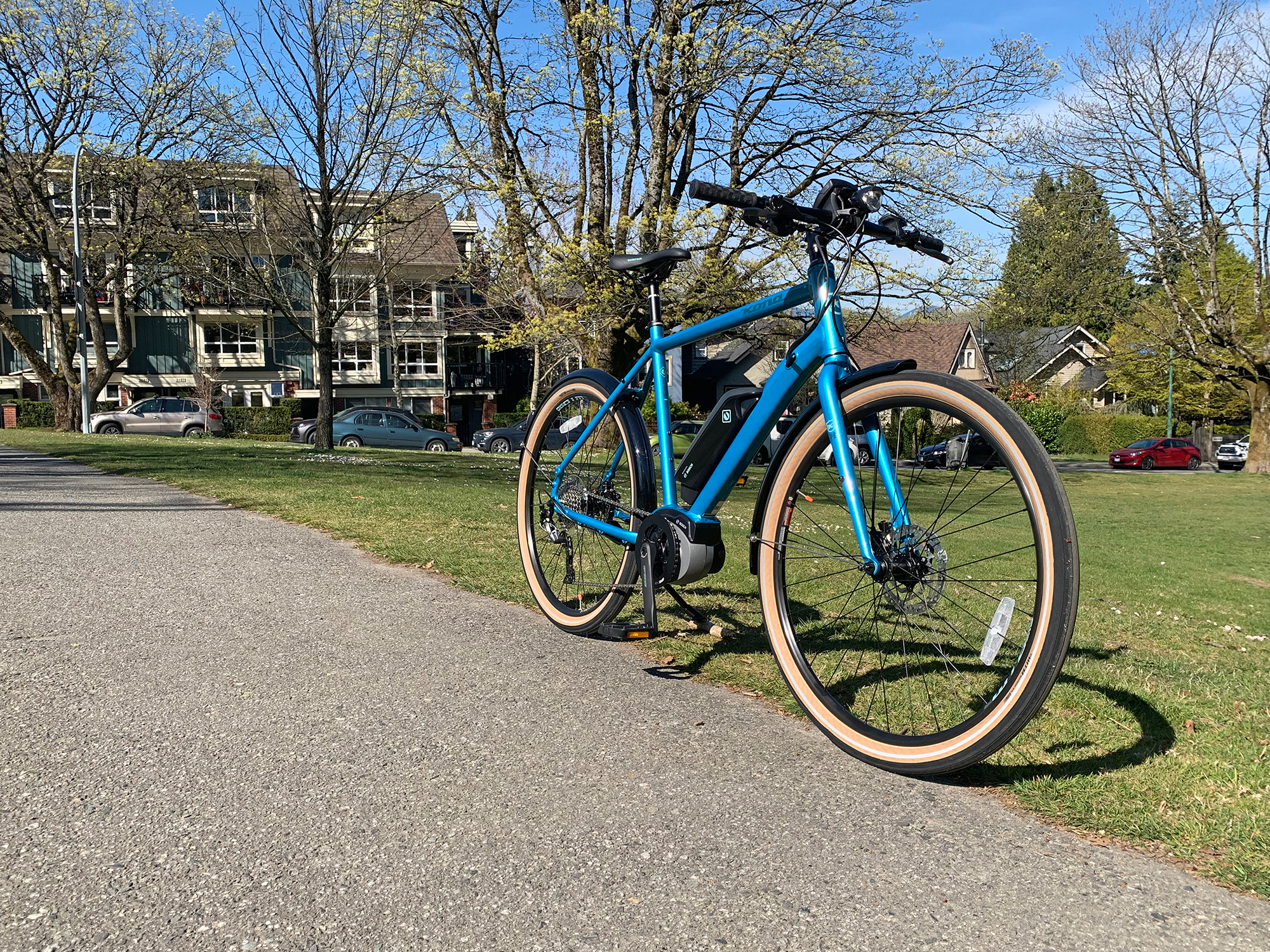
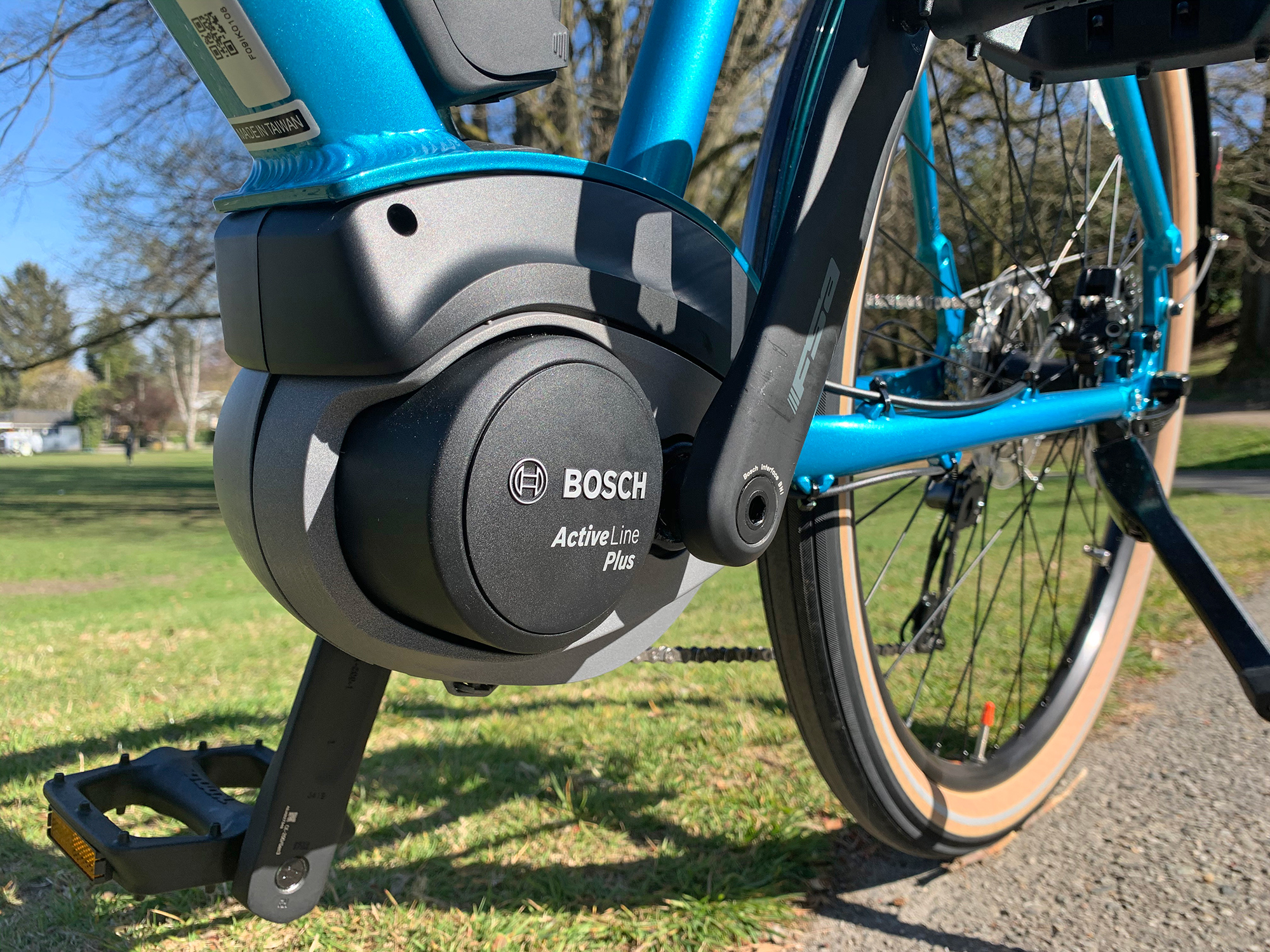
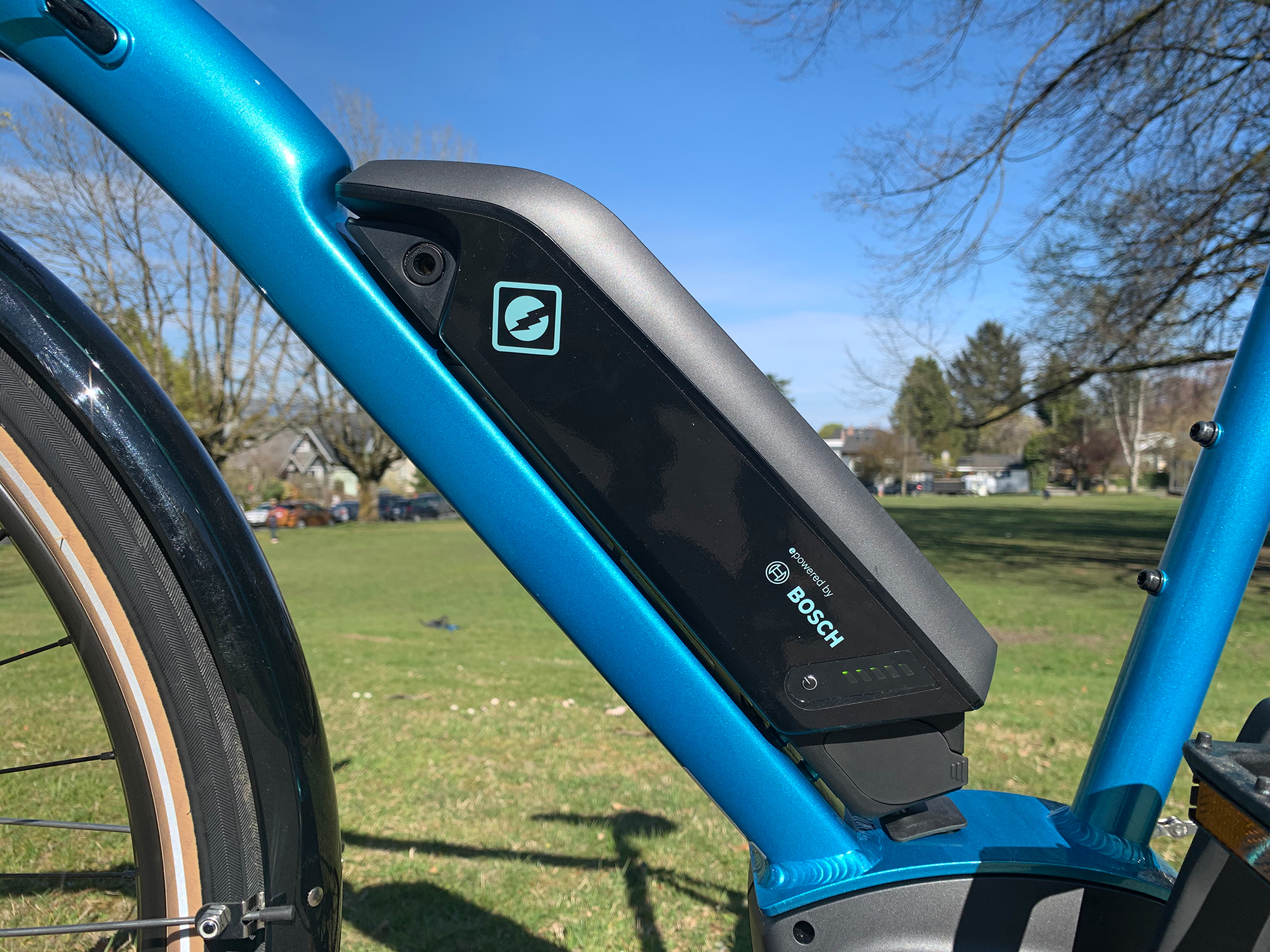
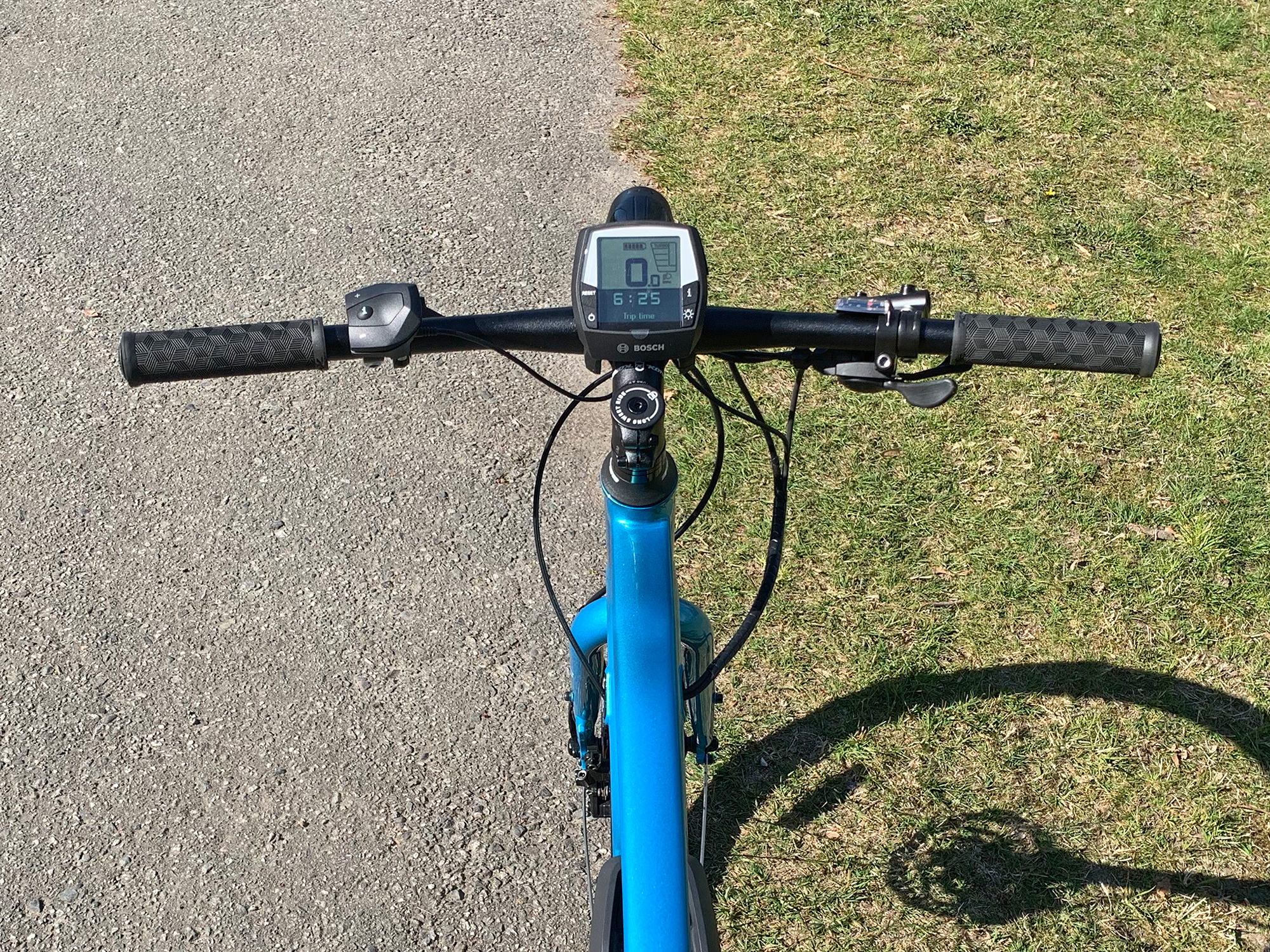
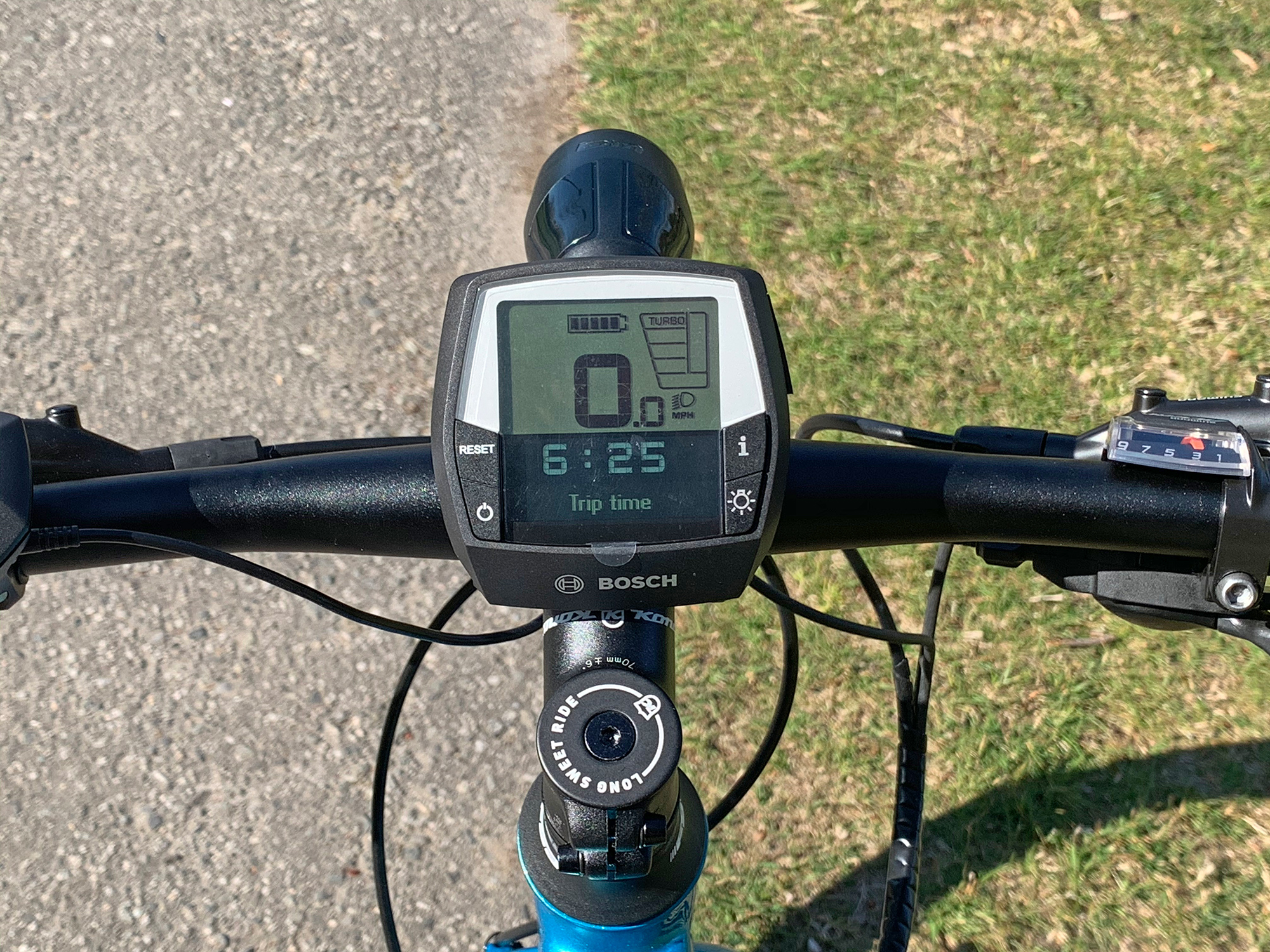

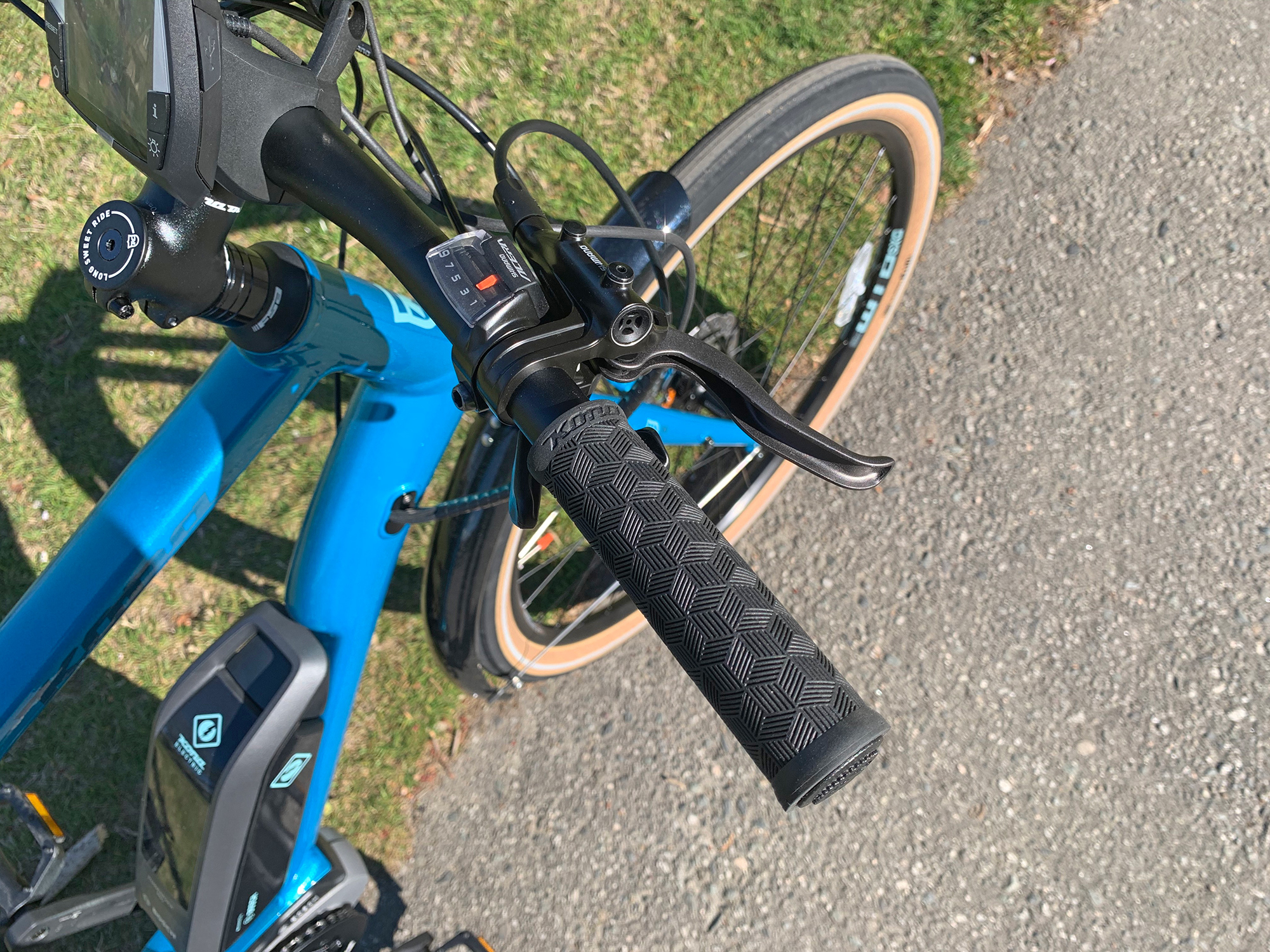
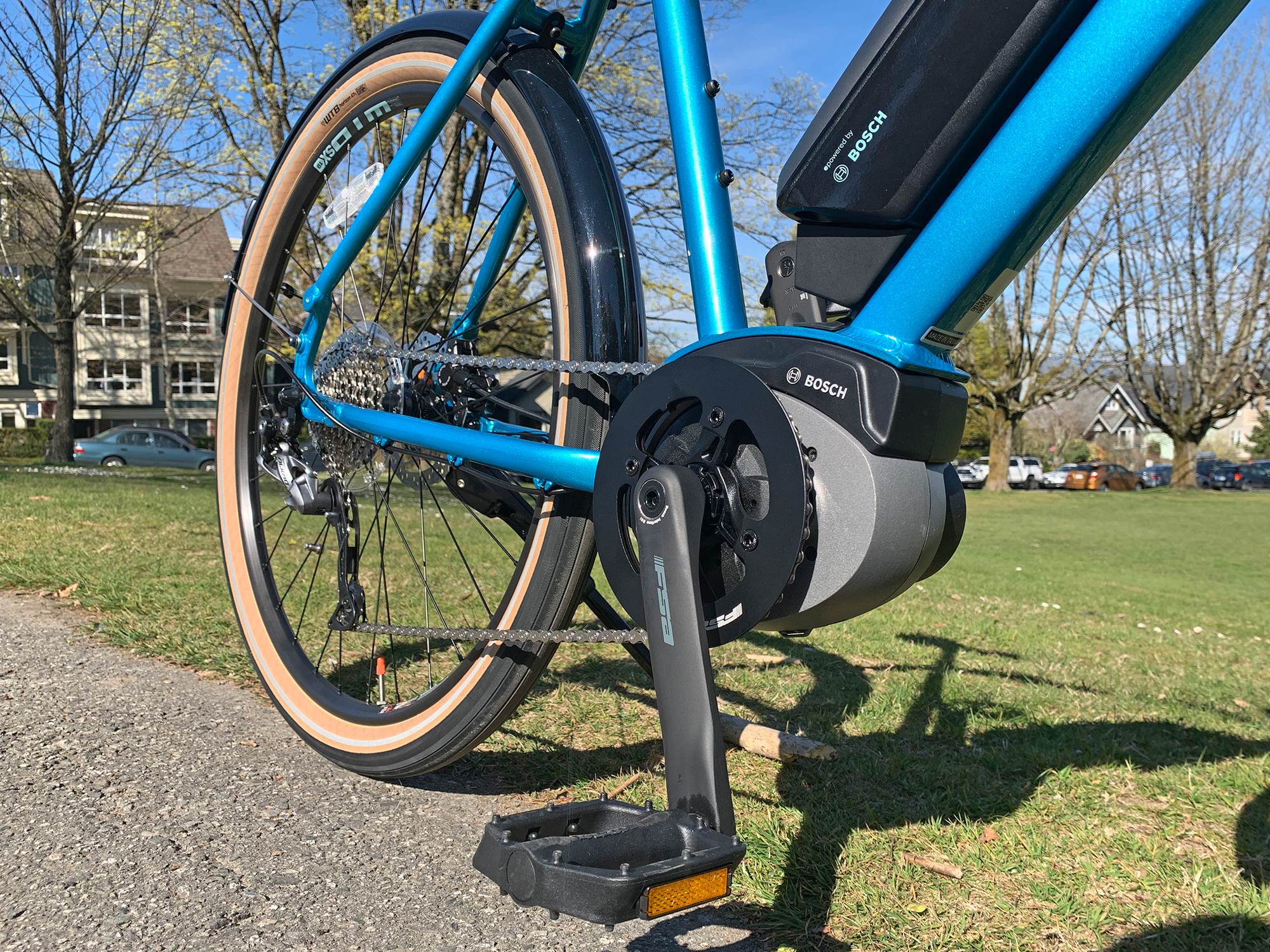
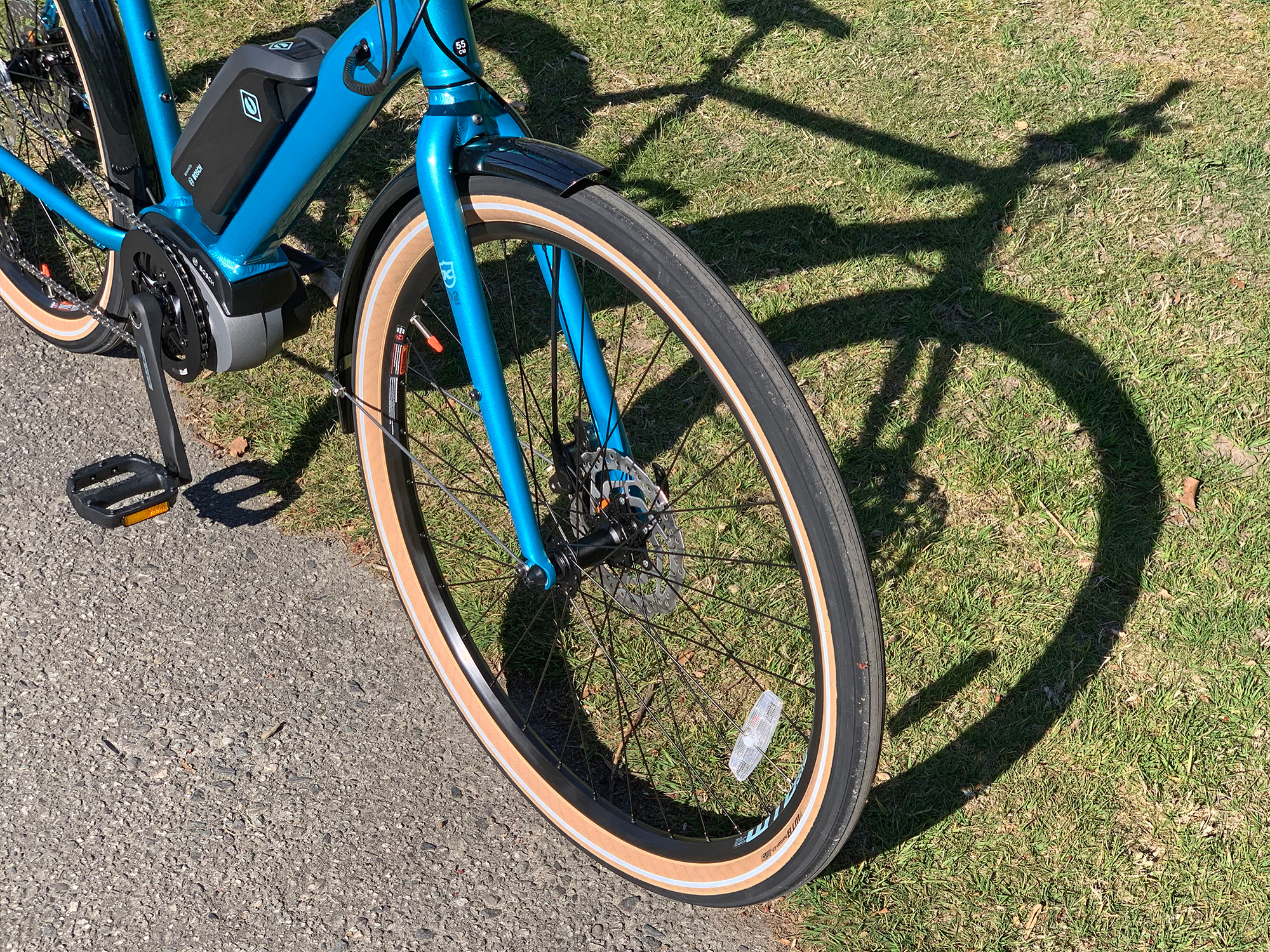
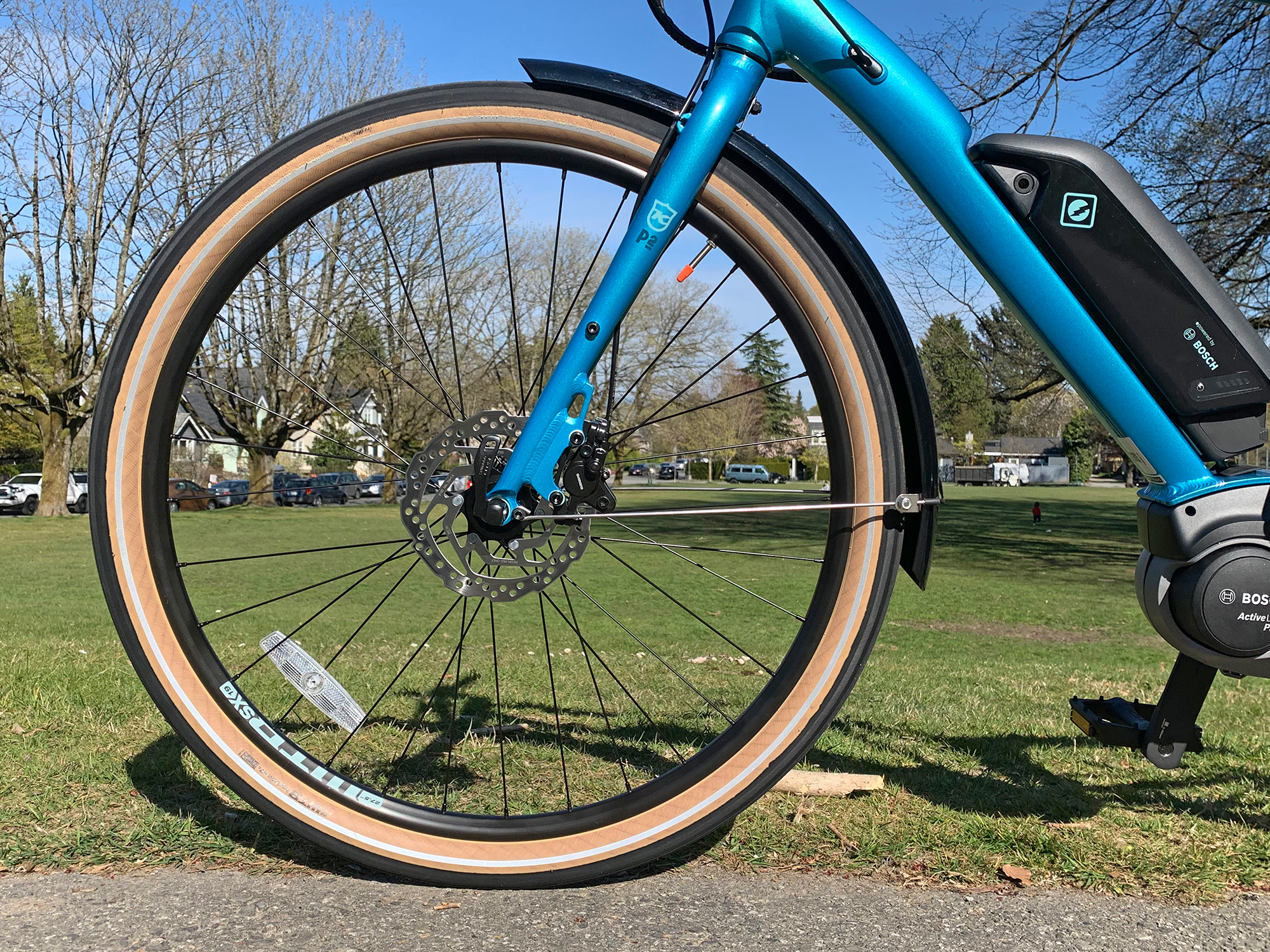
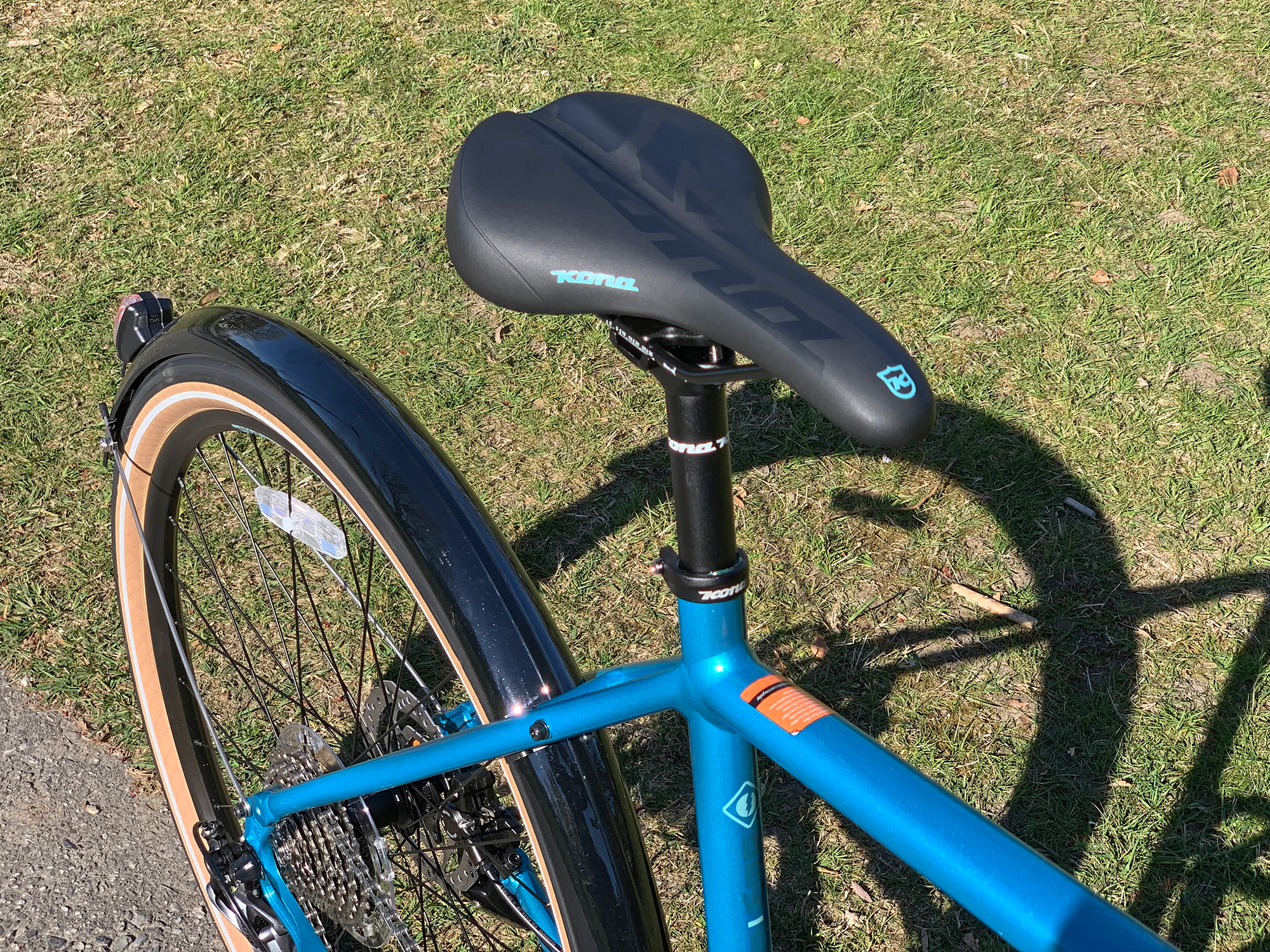

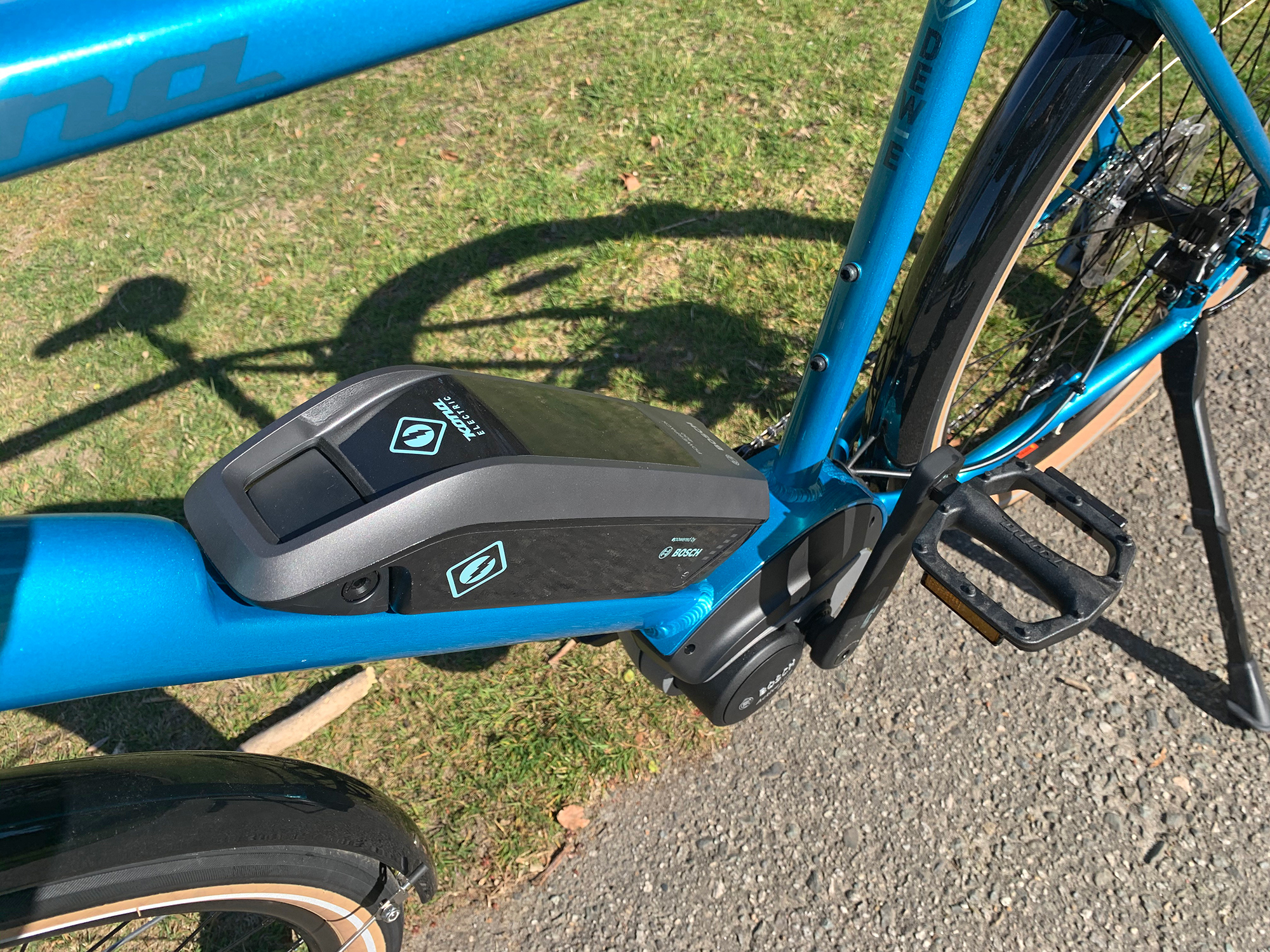
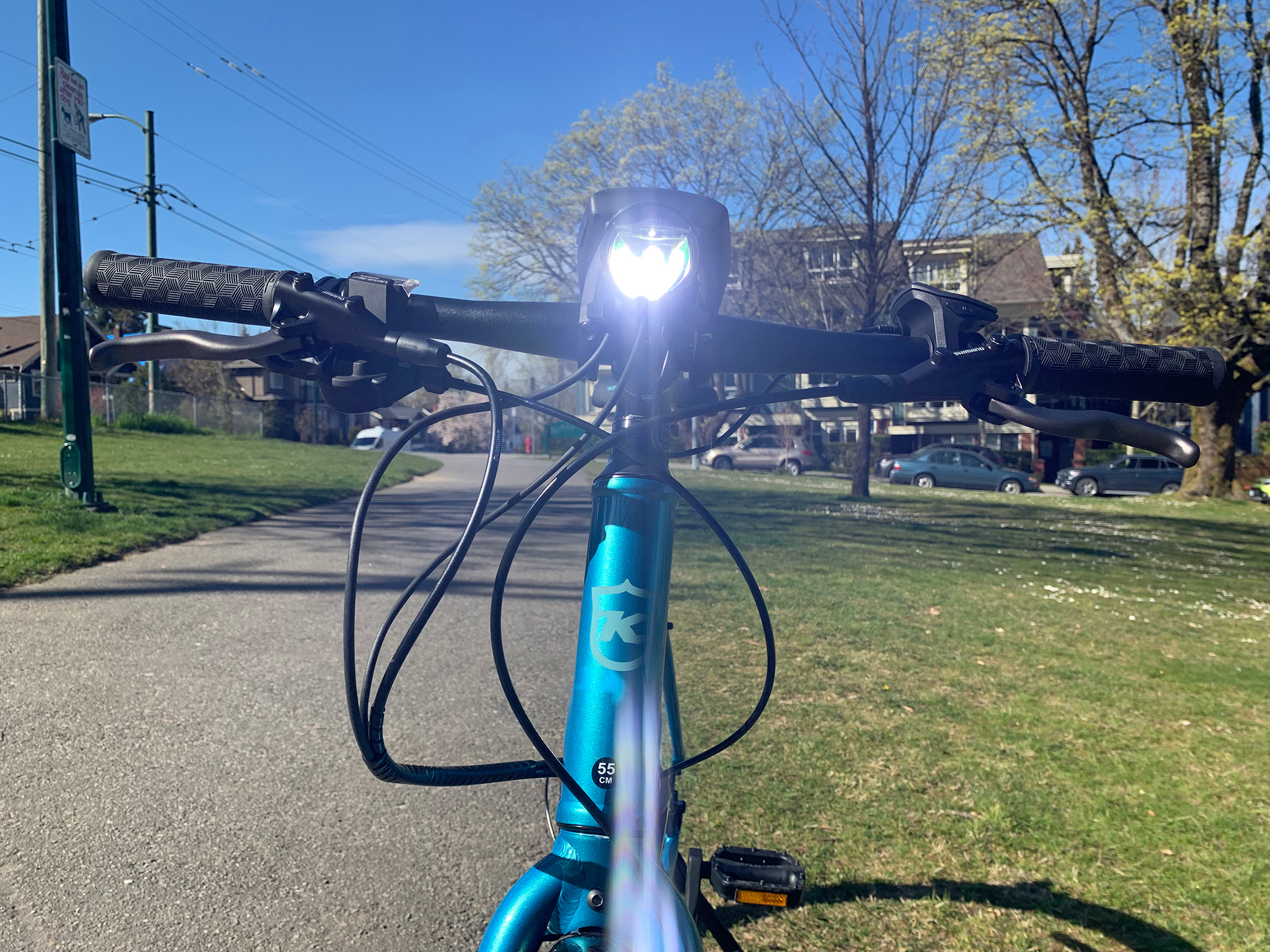
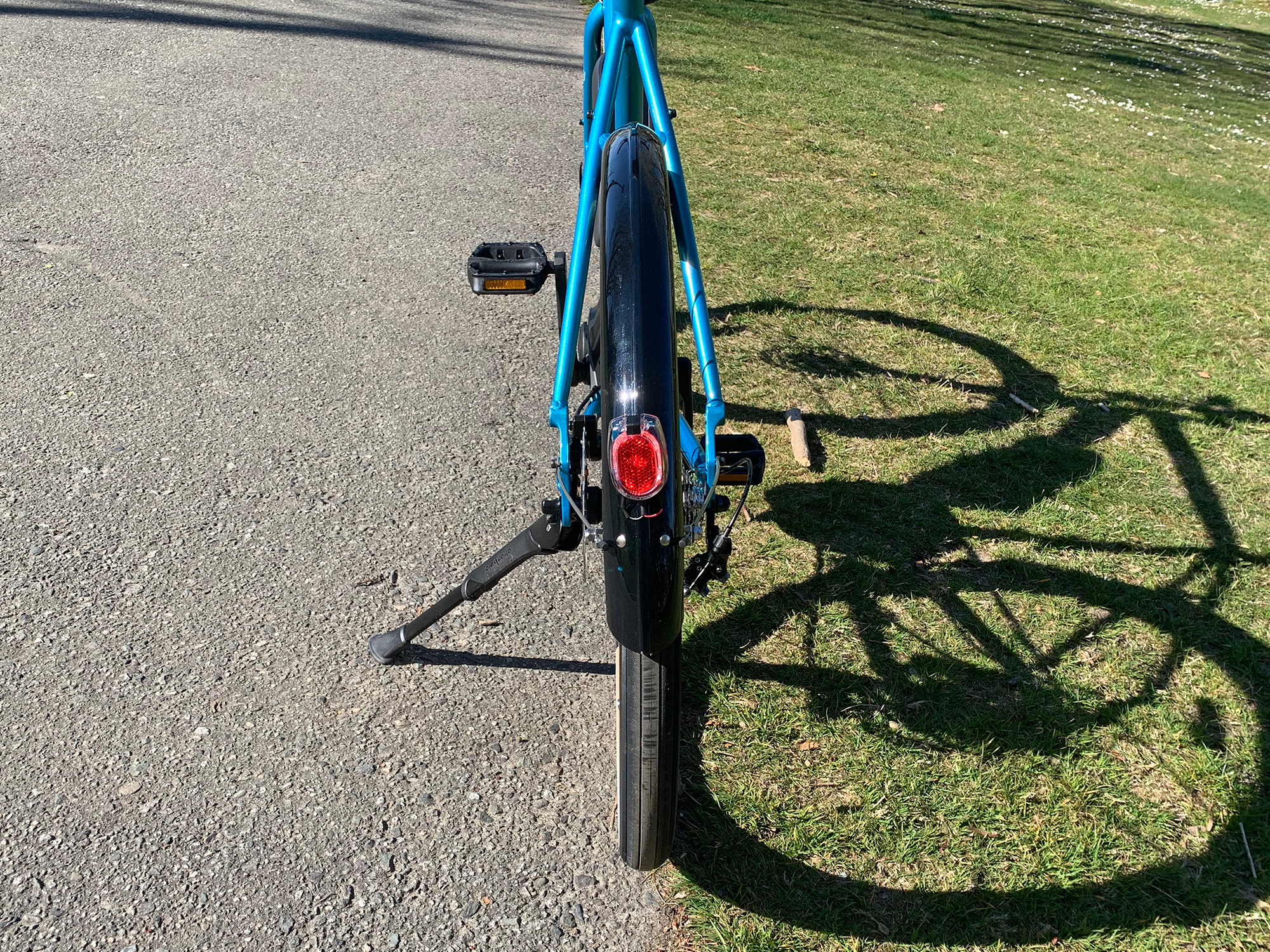
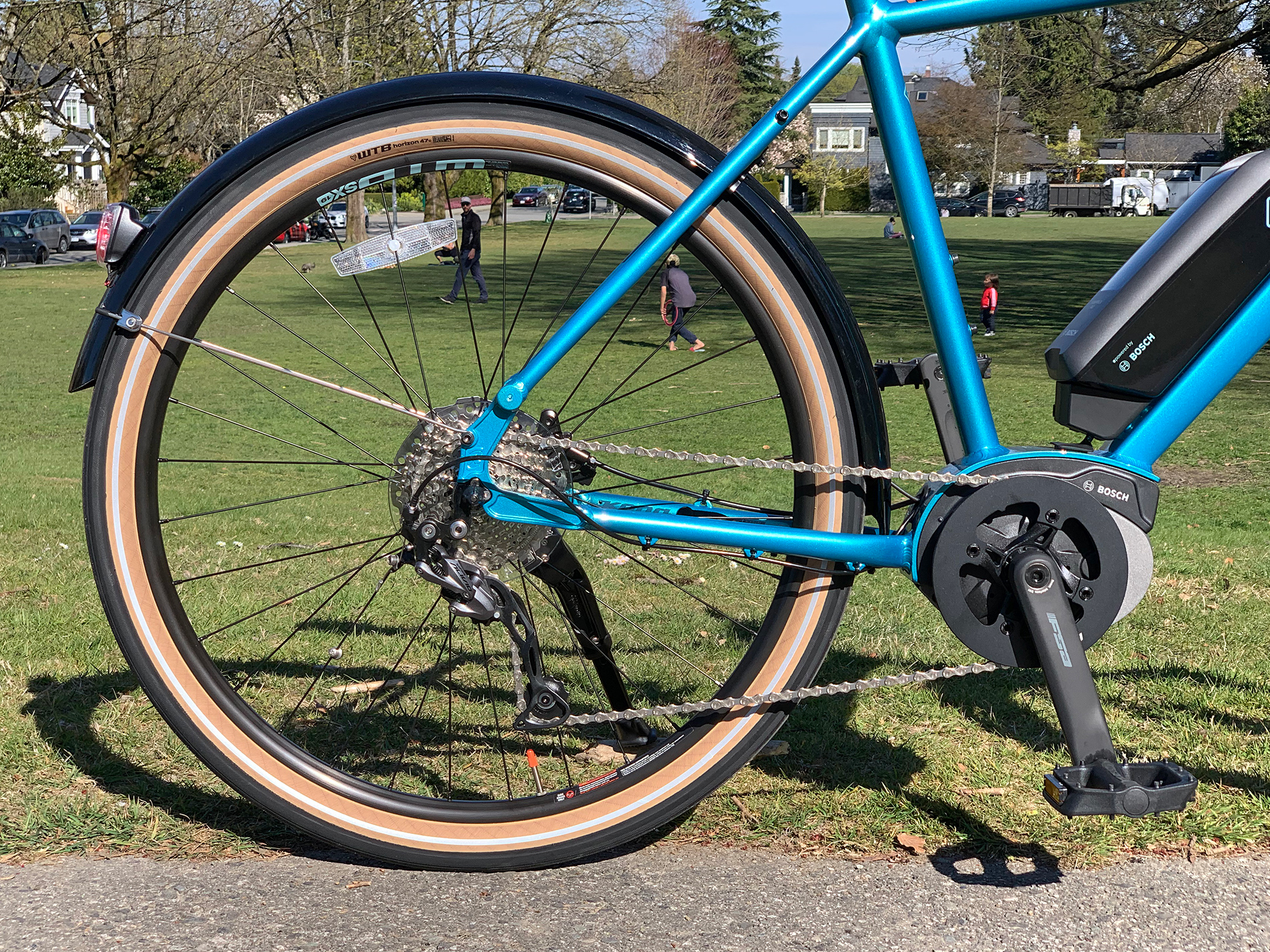
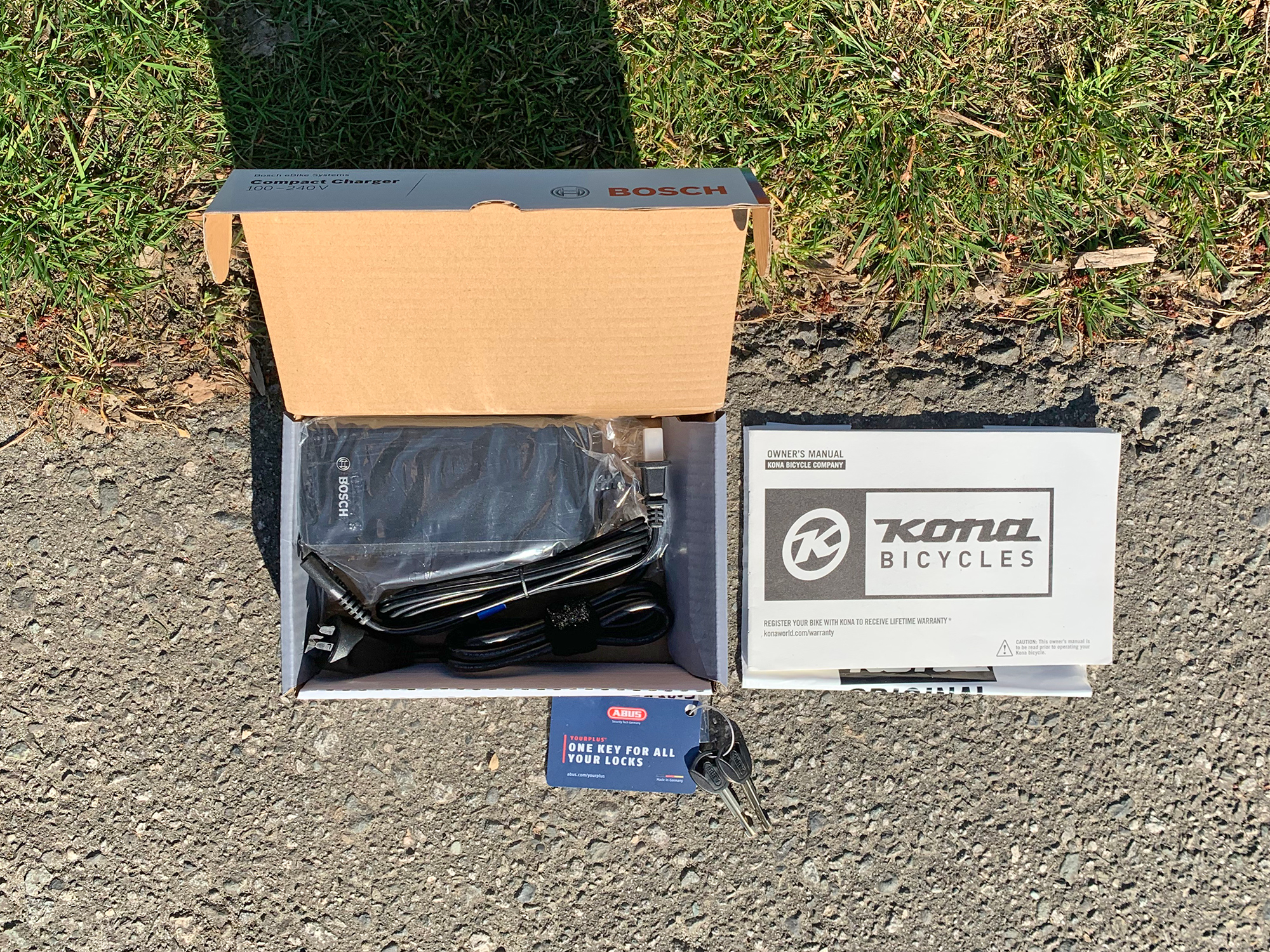


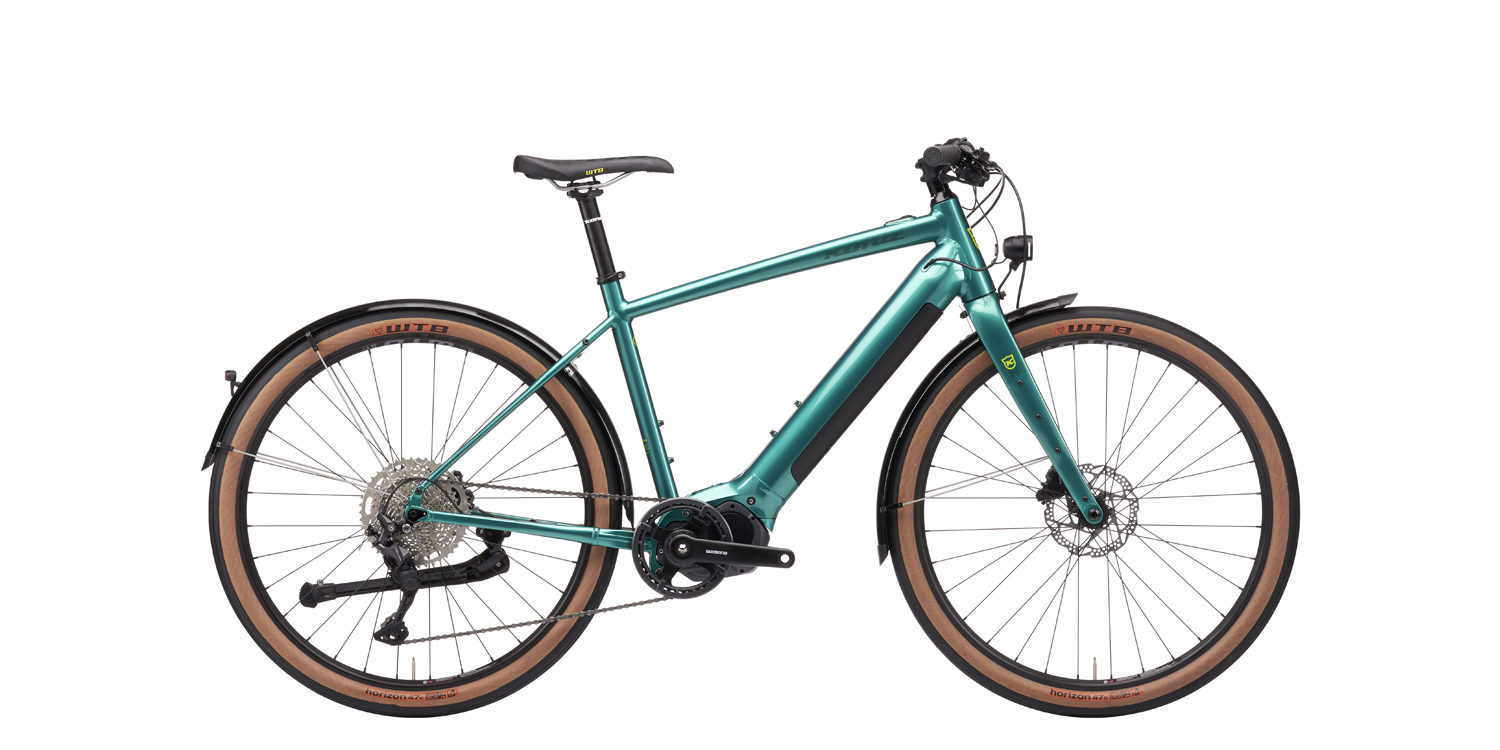
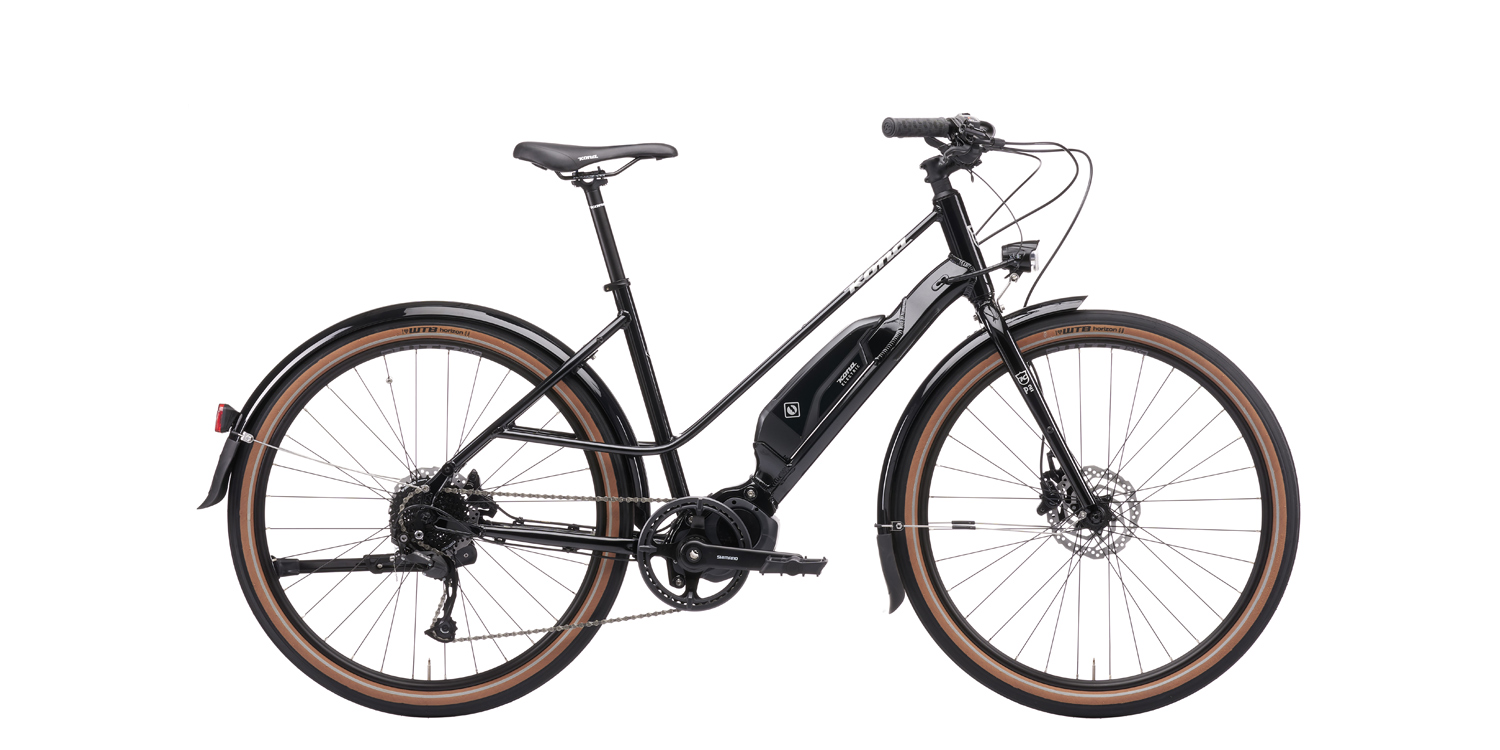
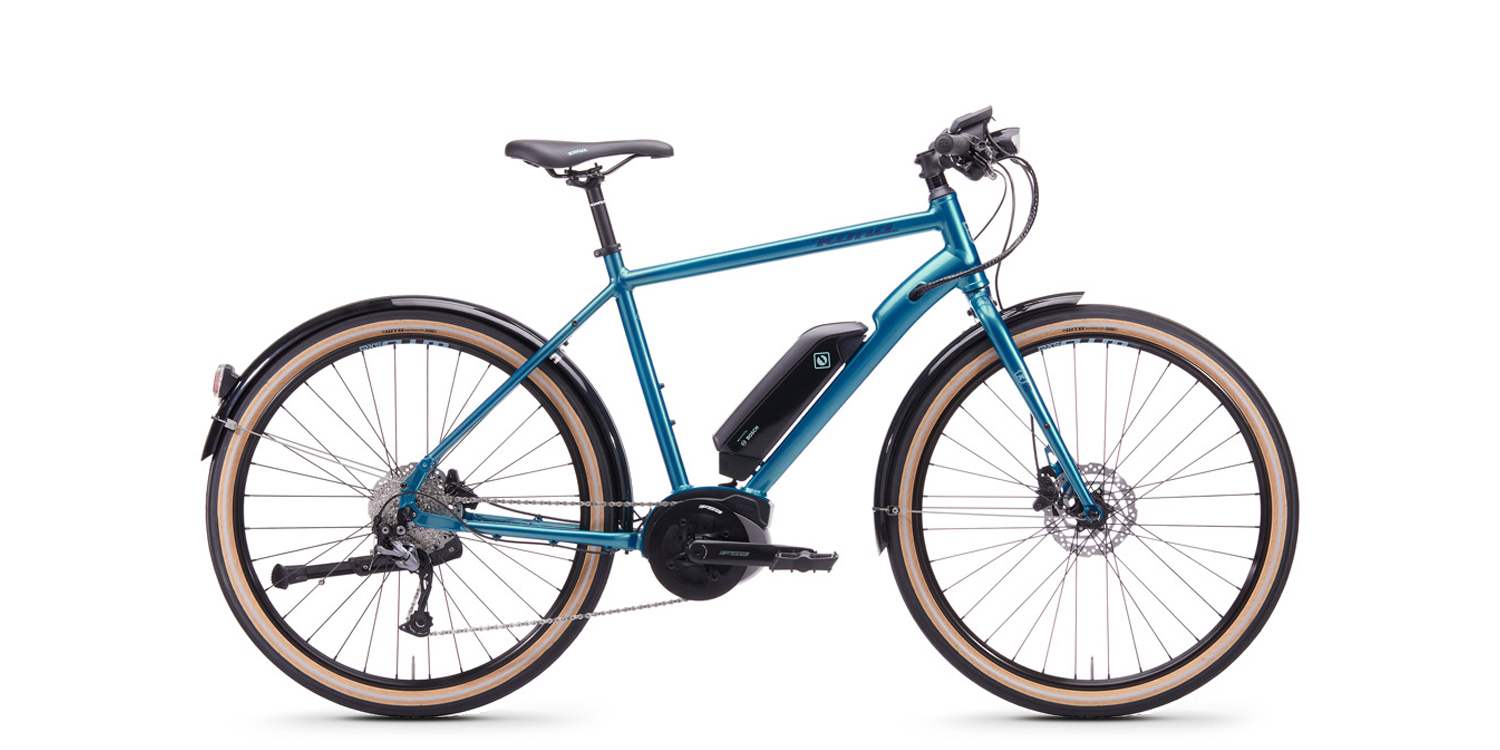
AlanK says
Thanks you for the thorough, honest review. This model is near the top of those I’m considering. I want something simple, versatile, and reliable that’s also reasonably efficient sans battery power. I really like that this bike doesn’t looks similar to a standard bike. Everything seems functional and purposeful; nothing seems superfluous.
My only minor gripe is the quick-release wheels rather than thru-axle. QR are fine, but since TA are stiffer and more durable they make sense considering the additional stresses and torque e-bikes can generate. Other than that it seems like a great bike.
Court says
Hi AlanK! Sorry for the little wait on my reply here. The Dew-E has definitely grown on me, but your point about thru-axles is a good one. Please look out for another great ebike review that will go live tomorrow morning (May 12th) that might fit your needs and be worth comparing. It’s similarly priced, does have thru-axles, and is very practical (fenders, rack, excellent lights). That model is going to be one of my top picks for all of 2020, so worth considering. I cannot talk about it yet due to press embargo, but keep an eye on the YouTube channel here.
To be more specific with the Kona here, I think that quick release skewers are fine for most city riding. There can be extreme differences between rider weights and gear, yet these 9mm axles have been employed for decades by virtually all companies without much issue. Ebikes can generate extra torque, but with a 250 watt nominally rated mid-drive, I think you’re probably fine. Many mountain bikes use the same wheel axle setup and they have very low gears, heavier wheels and tires, and can be moving at high speeds on the way down steep sections. Thru-axles are nice, but probably not completely necessary. The other ebike I’m posting tomorrow is also a speed pedelec, so I think that’s part of the reason they upgraded… and one version has a carbon fiber fork, so it might have been for strength there.
AlanK says
Thanks for the heads-up Court. I’ll definitely look for the review tomorrow. A simple, functional speed pedelec at this approximate price point would probably be as close to my ideal as reality gets.
Court says
Awesome, in case you didn’t catch it. Here’s the new Specialized Turbo Vado SL 4.0 EQ that I was referring to ;)
Rick Richard Molz says
Loved your review. Any thought about Kona switching from the Bosch to Schimano motor? I was sold on the Dew-e with the Bosch system, but not sure about Schimano. Your thoughts will help me. Thanks
Court says
Hi Rick, I actually really like the Shimano systems. They tend to be very power efficient, quiet, and reliable. Shimano doesn’t offer speed pedelecs, and their battery charger tends to be large and heavy compared to Bosch, but otherwise they are on par. I like some of their displays more (the removable transflective one) and in general I trust them. I hope this helps!!
Rick Richard Molz says
Hi Court – Thanks for helpful and unbiased information. Question: What are the implications of the Shimano not having speed pedalecs? Does this change it from being a class 1 EBike?
Court says
Hi Rick! No, I’m sorry that I might have confused things by introducing a topic that is not applicable to this bike. The Dew-E that I covered was Class 1 (pedal assist only, up to 20mph or 32km/h) but Bosch makes another motor called the Performance Line Speed that can support Class 3 (pedal assist up to 28mph or 45km/h) while Shimano does not. They only offer Class 1 for their entire line of products right now (to my knowledge), so I was just lumping that choice into their other minimalist display, compact motor etc. and calling them a “bike first” company :)
Rick Richard Molz says
I picked up my medium Dew-E a few weeks ago. Added a Thud-Buster seat post which helps with the stiffness of the frame.
This is a great bike. The Shimano motor is smooth, the bike handles very well at slow speeds and on rough terrain. Very good range. The bike is not all that heavy for an EBike and feels like a real bike. I have been seriously cycling for 45 years and moved to an EBike due to knee issues and some arthritis in my hands. Over those 45 years I have cycled coast-to-coast and in about 20 countries, mostly touring. I feel I can do more touring on this bike, which was no longer possible on my trusty Trek-520. I strongly recommend this bike. I got information from Court and also exchanged EMail with people at Kona on sizing and found both to be very helpful. Thanks!
Court says
Sweet! It sounds like you got the newer Dew-E that has a drive system from Shimano, more like the Dew-E DL that I recently covered (this review is a bit outdated and shows the Bosch motor). I agree with everything you wrote, and I think I prefer the standard Dew-E because the battery is light, easier to remove, and locks to the frame. Glad to hear that the folks at Kona helped you out, and you’re enjoying the bike Rick :)